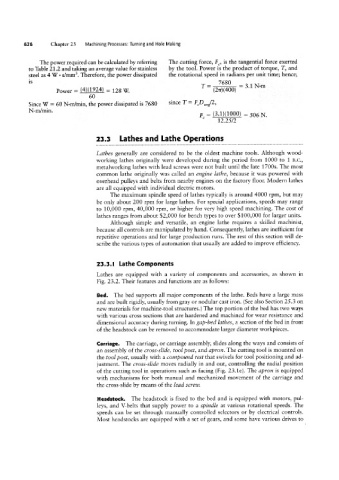Page 645 - Manufacturing Engineering and Technology - Kalpakjian, Serope : Schmid, Steven R.
P. 645
26 Chapter 23 Machining Processes: Turning and Hole Making
The power required can be calculated by referring The cutting force, FC, is the tangential force exerted
to Table 21.2 and taking an average value for stainless by the tool. Power is the product of torque, T, and
steel as 4 W s/mm3. Therefore, the power dissipated the rotational speed in radians per unit time; hence;
-
is 7680
T =---_ = 3.1 N~
Power = <4><;§24> = 128 W <2ff><400> “‘
Since W == 60 N-m/min, the power dissipated is 7680 Sinai T Z FfD.vg/2,
N-m/ _
mm Pc = (3.1)(1000) = 506 N_
12.25/2
23.3 Lathes and Lathe Operations
Lathes generally are considered to be the oldest machine tools. Although wood-
working lathes originally were developed during the period from 1000 to 1 B.C.,
metalworking lathes with lead screws were not built until the late 1700s. The most
common lathe originally was called an engine lathe, because it was powered with
overhead pulleys and belts from nearby engines on the factory floor. Modern lathes
are all equipped with individual electric motors.
The maximum spindle speed of lathes typically is around 4000 rpm, but may
be only about 200 rpm for large lathes. For special applications, speeds may range
to 10,000 rpm, 40,000 rpm, or higher for very high speed machining. The cost of
lathes ranges from about $2,000 for bench types to over $100,000 for larger units.
Although simple and versatile, an engine lathe requires a skilled machinist,
because all controls are manipulated by hand. Consequently, lathes are inefficient for
repetitive operations and for large production runs. The rest of this section will de-
scribe the various types of automation that usually are added to improve efficiency.
23.3.l Lathe Components
Lathes are equipped with a variety of components and accessories, as shown in
Fig. 23.2. Their features and functions are as follows:
Bed. The bed supports all major components of the lathe. Beds have a large mass
and are built rigidly, usually from gray or nodular cast iron. (See also Section 25.3 on
new materials for machine-tool structures.) The top portion of the bed has two ways
with various cross sections that are hardened and machined for wear resistance and
dimensional accuracy during turning. In gap-hed lathes, a section of the bed in front
of the headstock can be removed to accommodate larger diameter workpieces.
Carriage. The carriage, or carriage assembly, slides along the ways and consists of
an assembly of the cross-slide, tool post, and apron. The cutting tool is mounted on
the tool post, usually with a compound rest that swivels for tool positioning and ad-
justment. The cross-slide moves radially in and out, controlling the radial position
of the cutting tool in operations such as facing (Fig. 23.1e). The apron is equipped
with mechanisms for both manual and mechanized movement of the carriage and
the cross-slide by means of the lead screw.
Heaclstock. The headstock is fixed to the bed and is equipped with motors, pul-
leys, and V-belts that supply power to a spindle at various rotational speeds. The
speeds can be set through manually controlled selectors or by electrical controls.
Most headstocks are equipped with a set of gears, and some have various drives to

